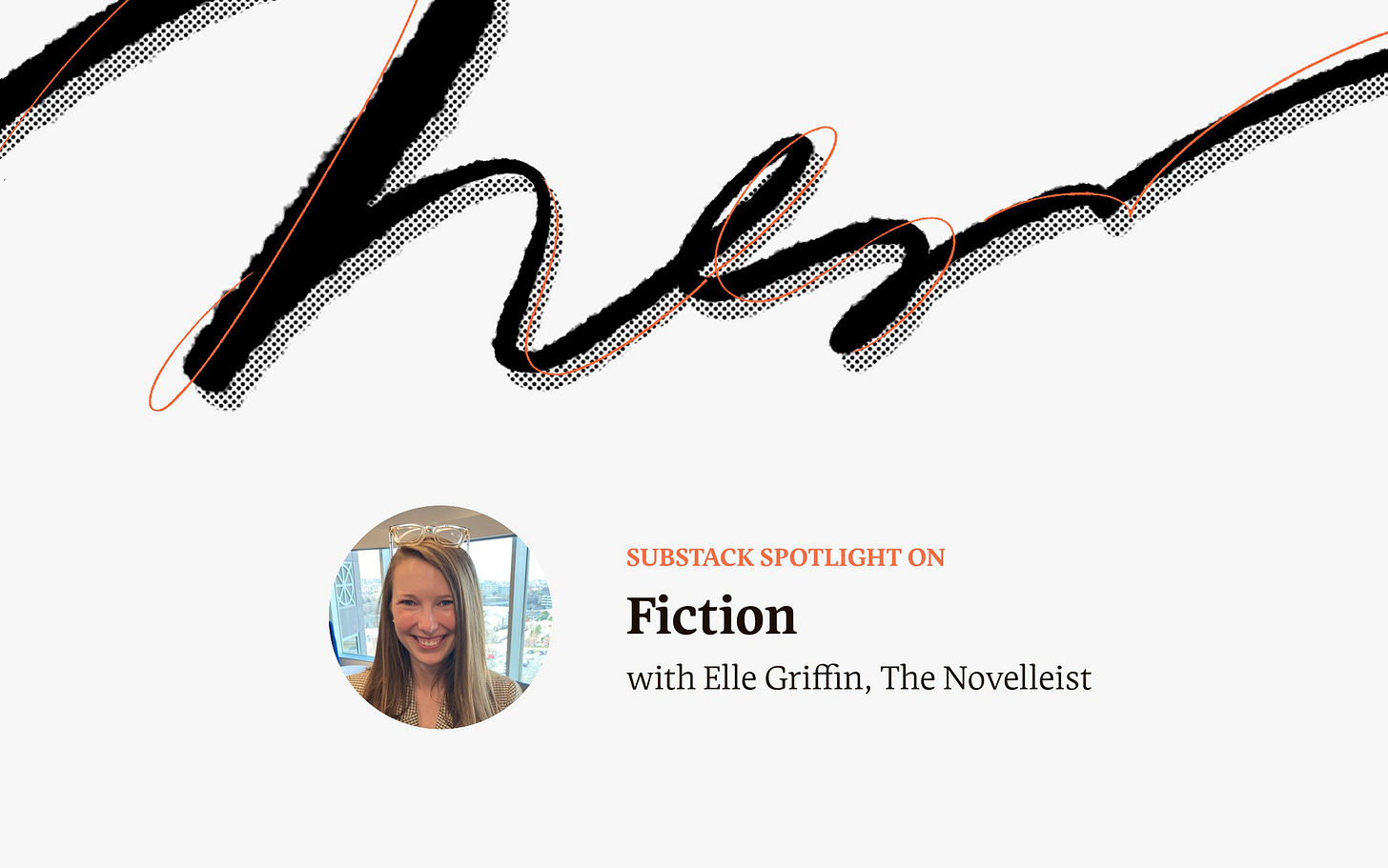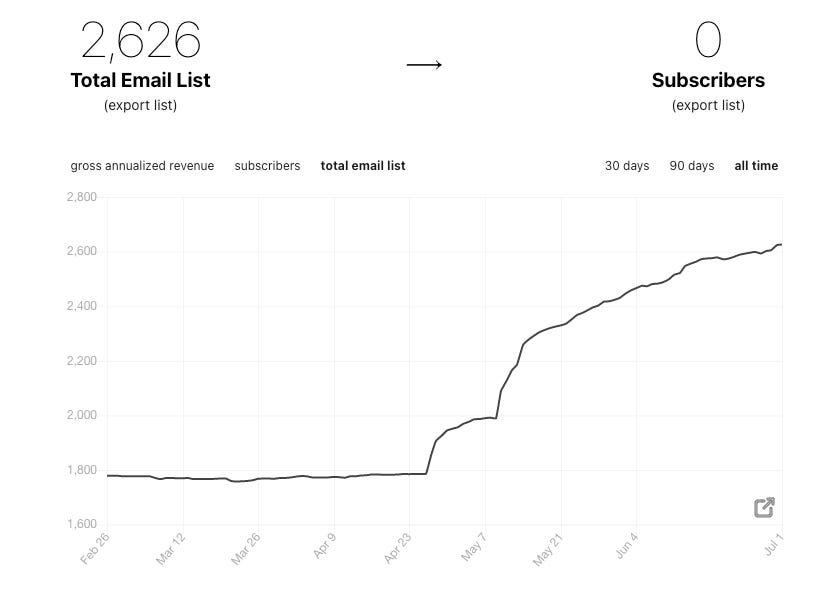Last Wednesday, we hosted a workshop with Elle Griffin of The Novelleist to learn about how to serialize fiction on Substack.
When Elle finished writing her first book, she began to research the best way to publish it, but what she found was distressing. 98 percent of books published in 2020 sold less than 5,000 copies, and traditional publishing offered few viable paths for less established authors to make a living. Elle summarized her learnings in a Substack post called, “The one where writing books is not really a good idea.” The article’s sharp analysis of the publishing industry hit a nerve, garnering the post more than 70,000 views.
In the article, Elle analyzes online platforms like Wattpad, Patreon, Amazon, and Substack as potential alternatives to traditional publishing. She makes the case that while there isn’t yet a perfect home for fiction online, Substack presented the most promising opportunity to publish and monetize her serial novel.
We asked Elle to host a Spotlight On because of the rigor with which she has approached serializing her fiction on Substack. Elle has also been uniquely generous to fellow writers in the fiction genre – finding and gathering nearly 500 writers in the Substack Writers Unite Discord group, and also spotlighting other writers on her own Substack.
The transcript has been edited for length and readability. You can listen to the full interview as a podcast in this post.
To sign up for future writer interviews and workshops, head here.
Why did you decide to serialize your upcoming novel on Substack?
After I finished writing my novel, I set out to do what every writer does: pitch it to agents. I pitched more than 120 agents, and they all rejected it.
As I was going through that process, I realized why all these agents were rejecting my book. It’s a strange little gothic novel. It’s a book that will appeal to a certain kind of person, but it won't appeal to every kind of person.
If you're a big publishing house, what you're looking for are blockbusters – the Dan Browns of the world who are going to write a novel that’s going to sell millions of copies. The publishing house takes 70% of those royalties, and that's how they fuel their business. Meanwhile, only 0.01% of books will sell more than 100,000 copies. In fact, 96% of books sell less than 1,000 copies total!
Well, my book is definitely not a blockbuster. If I'm only going to sell 1,000 or 2,000 copies – because that's about as big of an audience as I can picture – how can I effectively monetize it? If I put the book up for sale on Amazon for $3 each, then my family and 100 other people might find it, and I'd make a couple hundred bucks.
At the same time as I was researching the publishing industry, the creator economy was emerging. New tools are allowing creative people to monetize a really niche audience. It only takes 1,000 people paying $8 a month for a creator to make a living of $100,000 a year.
Writers were tapping into the creator economy through Substack, but most weren’t writing fiction yet. I knew writers charging people from $5 a month up to $40 a month; on Substack, there were people earning millions of dollars a year.
Here's this platform that already has the business structure ready to go, so I wanted to try it for fiction. If there are 1,000 people out there who are willing pay $8 a month to subscribe to my novel as a serial, then that would work out financially for me. I could fund my writing. After all, this isn’t a new idea. The Count of Monte Cristo, Charles Dickens, and more classic books were all initially serialized.
How have you grown your email list so far?
I started my Substack in February, and it has grown by almost 1,000 readers in the last two months.
In trying to grow my audience on Substack, I figured the easiest way would be to learn from other Substack writers. I stalked everyone I could find on Twitter who used the combination of the word “fiction” and the word “Substack” in a tweet. I messaged them and invited them to a Discord server so we could learn from each other. There are hundreds of fiction writers in the community now, all talking about what has worked and not worked for each of us. We have a little spreadsheet called “cross promotions” where we put in our Substack URL and genre so we can contact each other and exchange mentions of one other’s work.
But what was most helpful for growth was writing two articles that took me a really long time to produce. One took me all of 2020 to research. The other one took me another six months to research. Those two articles were about the publishing industry at large. It turned out that they resonated with people because publishing is a black box, and there are a lot of writers also trying to understand how it works.
I shared those two articles a bunch of different ways, including on Hacker News. You can share your link on there, and sometimes they go viral and sometimes they don't, but one of mine did. That article had something like 60,000 views in one day, and a lot of subscribers came from that one piece of writing that really resonated.
How are you approaching charging readers for a serialized novel?
Fiction writing is not the same as writing nonfiction on Substack. With nonfiction, you're expecting rolling admissions. You're getting new subscribers every month, and it doesn't matter where those new people start reading because the next article you publish isn't necessarily attached to the last one.
For fiction, the posts are sequential, so I’m following the funding model you see with an online course. In these courses, you have to take the first class before the second class. There is a clear order, and people running courses often open enrollment just once a year. During those enrollment periods, they send tons of promotional communication encouraging people to sign up for their course. After that period, the promotions die down.
That's how I'm going to approach it with my novel. September is my “enrollment period.” My plan is to publish the first four chapters in September to my entire newsletter list for free. At the bottom of each of those posts, I’ll tell readers that in order to keep reading in October, they’ll need to subscribe and pay an annual fee. I’m charging $10 a month or $50 a year, so my hope is to encourage everybody to buy into the full year in September – essentially, they’re buying the whole book by doing so. When October hits, my audience should be locked in. Everybody will be signed up to get the book as paid posts, and all of them will be receiving installments at the same time.
I plan to do this same process every year. This first book will be done in June. I'll have July and August off, and in September, I’ll start my second book. So there will be a new book in the same window of time as when Substack starts saying to readers, “Hey, by the way, your annual subscriptions are about to renew.”
I think this annual approach is easier on writers who aren't used to asking for money because you just need to do so once a year, and then you can focus on writing.
Elle’s extra tips for fiction writers
Use sections to delineate different topics and chapters. In addition to writing her novel, Elle publishes a Substack newsletter about fiction writing. She uses Substack’s sections feature to separate her posts into categories for readers, and shares in her demo (above) how other fiction writers are using sections to guide readers through the chapters of books.
Prepare for readers to join mid-story. Update: since this workshop was hosted, we have created a feature that allows writers to enable “next” and “previous” buttons on their posts in the Publication Details section of the settings page. This allows readers to quick navigate to sequential post.
Consider paid plans unique to fiction writing. Elle plans to publish four free chapters that go out to her entire list. After that, her chapters will be gated and paid. Elle noted that you can also try a founding member plan. Sasha’s founding plan includes a print copy of the book when it’s completed. Learn more about how to customize your subscription settings.
Hoping for more tips on how to start a fiction publication on Substack? Join Elle’s Discord community here.
Spotlight On is a series of live events hosted by Substack. The goal is to learn from writers across categories who have experienced success on Substack. Stay tuned for our next events here.












